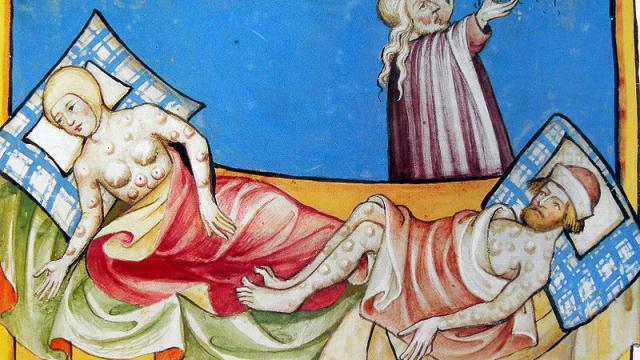Scientists have long known that one little microbe is responsible for the infamous Black Death plague that decimated Western Europe in the Middle Ages, wiping out roughly one-third of the population. Now they have learned more about where it comes from: it takes just a few small genetic changes to turn a mild stomach bug into a killer.
At the height of the plague years, the Black Death spread so fast, it could wipe out entire villages within weeks. Even doctors feared treating victims, believing the disease spread via “bad air.” (Hence those large beaked hats depicted in so many medieval illustrations: doctors would stuff the beak with strong herbs and spaces to “purify” the air — and possibly to mask the stench of rotting flesh in the bargain.)
The plague is actually caused by a bacillus called Yersinia pestis (Y. pestis for short), spread by rodents and their fleas to humans. It’s so virulent that injecting mice with a mere three bacilli was sufficient to kill them in experiments — and a single flea bite can transmit 24,000 of the deadly microbe. Really, it’s amazing anyone survived the Black Death at all.
Genetically, however, Y. pestis isn’t much different from a microbe that, at worst, will give you the runs. As Carrie Arnold writes in Quanta:
Recent genetic work has traced the plague’s evolutionary precursor back to the relatively harmless gastrointestinal pathogen Y. pseudotuberculosis, which only causes mild diarrhoea. “Some people don’t even know they have it,” said Wyndham Lathem, a biologist at Northwestern University who has spent his career studying the plague bacterium. “Yersinia pestis can kill you in three days, and only a few changes were required to make this switch.”
Moreover, these changes did not occur very long ago. In several recent studies, researchers compared plague bacteria samples from two pandemics. The Y. pestis DNA recovered from London’s plague pits and from German graves dating from the plague of Justinian turned out to be largely the same. In addition, bacterial samples from modern plague victims around the world reveal very little variation. The findings indicate that Y. pestis hasn’t yet had time to accumulate lots of mutations. “Yersinia pestis is such a recent species that there’s not very much genetic diversity among plague strains, even the ones from historic graveyards,” said Joe Hinnebusch, a plague researcher at the National Institute of Allergy and Infectious Diseases. The bacteria’s murderous adaptations are only a few thousand years old.
Those small mutations involve a protein called urease, found in the bacterium’s protective coat, as well as a gene that codes for a protein — unique to Y. pestis — that prevents the clotting of blood. Without that genetic mutation, blood clots would otherwise trap a plague bacterium, preventing it from multiplying and spreading throughout the host.
You can read more about the mutant genes behind the Black Death over at Quanta.
[Quanta]
